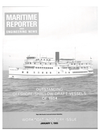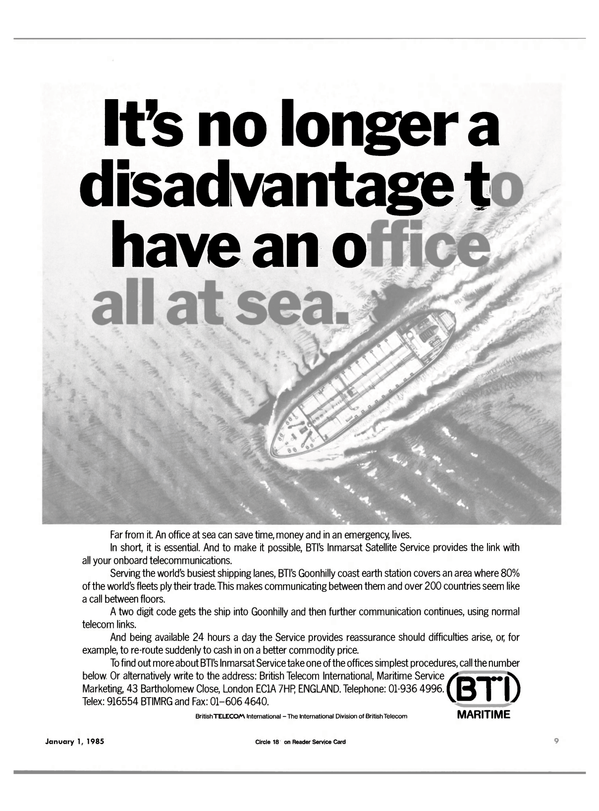
Shaft Coupling Saves Time And Money For Northwest Boatbuilder
The marine industry is now successfully using an "unconventional" shaft coupling combining a high torque-carrying capability with ease-of-mounting and dismounting.
Classified by Lloyd's, ABS, and DNV, among others, SKF OK couplings prove to be a simple, safe and fast way of connecting two shafts.
OK couplings are manufactured by the Coupling Division of SKF Steel, Inc., whose U.S. headquarters are in Avon, Conn. The coupling's range includes more than 100 standard sizes for shaft dimensions from 25 mm to 1,000 mm; torque transmission capacities range from 350 Nm to 26,000,000 Nm.
Located on the Guemes Channel, Port of Anacortes, Wash., Dakota Creek Industries, Inc. uses ASK OK170HB couplings in the manufacturing of their commercial marine vessels. According to Dakota Creek president Dick Nelson: "We presently save 50 percent of our machinist's time during installation because the couplings have no flanges, don't need bolts, nuts, or keyways, and eliminate the need for thrust rings." Because split bearings are unnecessary and the coupling uses less space than a flange, machinery room layout is simpler.
Dakota Creek was founded in 1977 by a group of boatbuilding veterans. Coached by their fathers and grandfathers, they learned their crafts in Northwest shipyards.
Their boats fish the waters from the Puget Sound north to the Bering Sea; their tugs work on the North Slope and berth tankers.
The Dakota Creek Industries' production yard comprises facilities for new construction and repair. It is equipped with platens, 250-foot building grids, mobile cranes, backup outfitting, repair piers, and marine railways. The yard has built 21 hulls, among them, the 123-foot crabber/trawler Morning Star, the 100-foot bowpicker Alliance, and the 95-foot harbor tug Philip W.
"We accommodate the owner's design wishes when laying out the vessel," says Mr. Nelson. "We take pride in our work, and that pride shows up in out boats." Built for Alyeska Ocean, Inc. and launched recently for its maiden voyage to Alaska, was the 131-foot trawler Aldebaran, which is the brightest star in the constellation Taurus. Aldebaran's diesel engine propeller shaft is low in the hull to leave more cargo room topside.
Used in constructing the Aldebaran were three SKF OK170HB couplings, interconnecting the line and tail shafts and one OKF170HB coupling at the reduction gear box and C.P. unit. The whole shaft-line was installed through the stern-tube.
Elimination of keyways meant a reduced shaft diameter and as much as 25 percent savings in machining costs.
The ASK OK170HB coupling has a thin inner sleeve with an external taper; the tough outer casing has a correspondingly tapered bore. The bore diameter of the inner sleeve is larger than the diameter of the shafts, allowing the coupling to slide easily over the shaft joint. Actual connection is made when the outer sleeve is pressed up over the tapered sleeve with the aid of oil under pressure; oil injected between the tapered surfaces eliminates friction when mounting. The oil is drained away when the outer sleeve reaches its correct position, and a powerful interference fit grips the shafts.
Torque transmission capacity is 128,000 Nm.
The yard stated they first used the SKF coupling in 1981, and it is low maintenance, dependable, effective and trouble free. In spite of the fact that the OK coupling is more expensive to purchase than some conventional couplings, Mr. Nelson stated he looked forward to saving 25 percent in the long run and to continue increased production because of decreased installation time.
A free color brochure is available describing the SKF170HB coupling in full detail. For a copy, Circle 24 on Reader Service Card
Read Shaft Coupling Saves Time And Money For Northwest Boatbuilder in Pdf, Flash or Html5 edition of January 1985 Maritime Reporter
Other stories from January 1985 issue
Content
- Call For Papers Issued By SNAME New England For Computer Symposium page: 4
- Newman's Revises Catalog On NEWCO Cast Steel/ Pressure Seal Valves page: 5
- Couch Named President Of Matson Navigation— Wasacz President Of A&B page: 5
- SecNav Lehman Announces Contract Awards Totaling Almost $2 Billion page: 5
- Perkins Joins Seaward International As Senior Sales Engineer page: 6
- Hyde Names Two New Vice Presidents page: 6
- Another Fast Delaware Pilots Boat Delivered By Gladding-Hearn Yard page: 6
- Shaft Coupling Saves Time And Money For Northwest Boatbuilder page: 7
- Hyundai To Build Four Rigs For ODECO At Total Cost Of $260 Million page: 7
- RDI Announces $15-Million Agreement With China For Electronic Shipping Safety Systems page: 7
- 1985 A YEAR OF CHANGE AND CHALLENGE page: 8
- Newport News Shipbuilding Delivers Attack Submarine 'Olympia' page: 8
- Fifth Generation Of Family Named To Executive Posts At Hughes Companies page: 8
- Butterworth Announces A New SCAMP Underwater Hull Cleaning Station page: 8
- New Chief Seattle Fireboat Provides High-Speed Response page: 10
- New York Port Engineers' Society Tours MarineSafety Simulators page: 11
- Todd Awarded $30 Million By Navy To Modify First Aviation Support Vessel page: 11
- Armco Offers Brochure On Bigger And Better Aquamet Boat Shafting page: 12
- Recent Order For Two Schottel Thruster Units A First In U.S. Market page: 13
- Weld Fittings Available From Cajon Company page: 13
- Marystown Shipyard Building 225-Foot Deutz-Powered Tug/Supply Vessel page: 14
- COMPUTERIZED VESSEL MANAGEMENT SYSTEMS page: 14
- BIW Will Get $383.6-Million Navy Contract To Build Two Aegis CG-47 Cruisers page: 15
- OUTSTANDING OFFSHORE/SHALLOW-DRAFT VESSELS OF 1984 page: 16
- Marconi Introduces The New Oceanray SAT-COM page: 22
- Ingram Purchases Assets Of Ohio Barge Line And Mon-Valley Transportation page: 22
- Bay-Houston Towing Offers 'Port Reference Handbook' For Six Gulf Ports page: 23
- Eisert Named To Head General Electric's New Navy Programs Section page: 26
- Daewoo To Build Tanker For Norwegian Company For $40 Million page: 26
- Tracor Marine Awarded $2.5-Million MSC Contract To Operate Research Ship page: 28
- Navy Awards Bell Aerospace Textron $27.3-Million Contract For New Minesweeper Hunter page: 28
- Gerard M. McAllister 1910-1984 page: 29
- Diesel Engine Manufacturers Continue To Improve The Fuel Efficiency Of Their Engines page: 30
- KHD Introduces Two Systems For Worldwide Engine Monitoring Via Satellite Communications page: 45
- Sea Data Corporation Introduces Deep Sea Instrumentation Cable page: 46
- Kastalon Offers New Brochure On Polyurethane Crane Bumpers page: 47
- Goodway Offers New Catalog On Tube Cleaning Systems And Pressure Washers page: 47
- Armco And Oerlikon Sign Joint Manufacturing/ Marketing Agreement page: 48
- Carroll And Tomlin Named Vice Presidents At National Marine's Shipyard Division page: 49
- Puroflow Marine Introduces New Integrated Power-Line Protection System page: 53
- Navy's New Double-Deck Pier To Be Fitted With Sea Guard Fenders page: 53
- Rockwell Offers Brochure On Autonetics Division's Products And Capabilities page: 59
- New Quick-Connects Introduced By Crawford Fitting Co. page: 59


